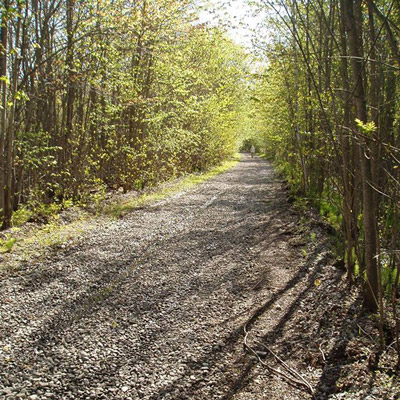Welcome to the landing page for Historical elements related to the Consecon area, some of which are displayed in the Trail Kiosk at Salem Road.
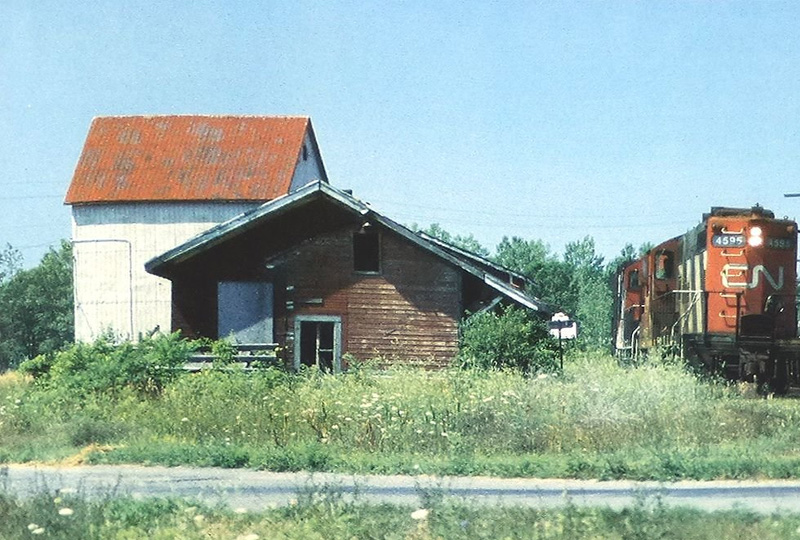
Early 2010s – possibly the last image of a train at Salem Road
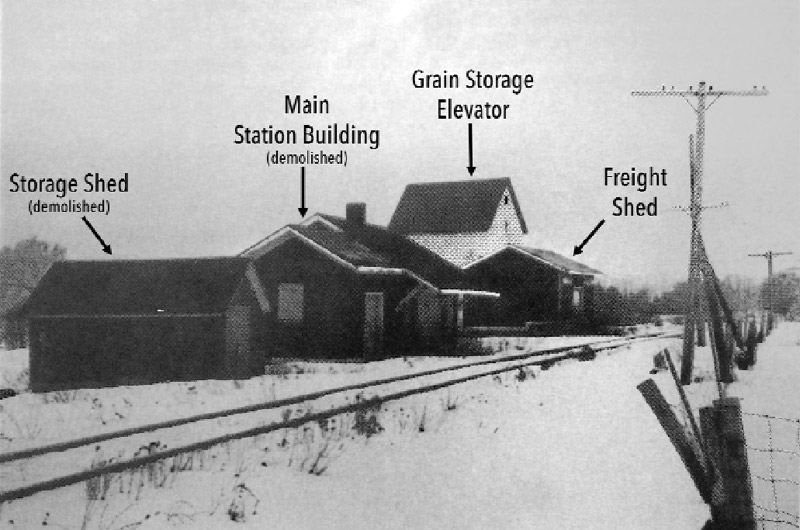
Consecon Station in 1979
[Photo James Plomer]
The first train stopped here at the Consecon Railway Station in October, 1879. That’s when the Prince Edward County Railway was opened to run from Picton to Trenton as a branch line of the Grand Trunk Railway. The rail line had been first proposed in the 1850’s to run all the way to Long Point Harbour in the south-east corner of Prince Edward County, however, the final 30 kilometers to Long Point were never constructed. The main station building at Consecon is now gone and only the freight shed and the grain storage elevator remain as a reminder of the importance of transportation to the growth and prosperity of Prince Edward County.
More than two hundred years earlier, this area was the site of several settlements of Indigenous North American peoples. Used for millennia as hunting grounds by the Wendat, Anishinaabek and Haudenosaunee peoples, by the 1660’s a village had been established in the vicinity of Consecon by the Cayuga Haudenosaunee whose traditional homeland was located south of Lake Ontario in upstate New York. Under the leadership of Chief Rohario, a Cayuga band had moved across the lake to settle in what is now Prince Edward County.
In 1668, as part of a peace settlement to end the warring between the Haudenosaunee and the colonists of New France along with their Anishinaabek and Wendat allies, Chief Rohario allowed French missionaries to establish the Kenté mission among his people. After twelve years, however, the Sulpician priests had abandoned the mission and the Cayugas eventually left the area. Haudenosaunee peoples would not settle again in the Quinte region until the Mohawks from New York State were granted land along with the Loyalists after the end of the American Revolutionary War in 1783.

Land in the Consecon area was granted to several Loyalist veterans of the war including Captain Stinson of the King’s Rangers whose block of land still bears his name. Seven kilometers north of here, at the Carrying Place (kilometer-zero on the Millennium Trail), “late Loyalists” Asa Weller and Robert Young were the first permanent European settlers in that area. The Carrying Place is a portage from the Bay of Quinte to Wellers Bay and Lake Ontario that had been used for centuries by First Nations peoples. It was at this neck of land that Weller built a railway with wooden rails on which he ran a flatcar pulled by a team of oxen to move small boats and cargo overland across the Carrying Place. Just east of the Millennium Trail (at the corner of Fort Kente Road and Gardenville Road), you can still see one of Weller’s later homes, a red brick house, as well as Robert Young’s yellow frame house, both built in the early 19th Century. During the War of 1812, the Carrying Place was a strategic transportation point; essential to move British troops and Canadian militia and their provisions up and down Lake Ontario. During that conflict, this portage also saw the passage of American prisoners of war who were being taken under guard to Kingston.
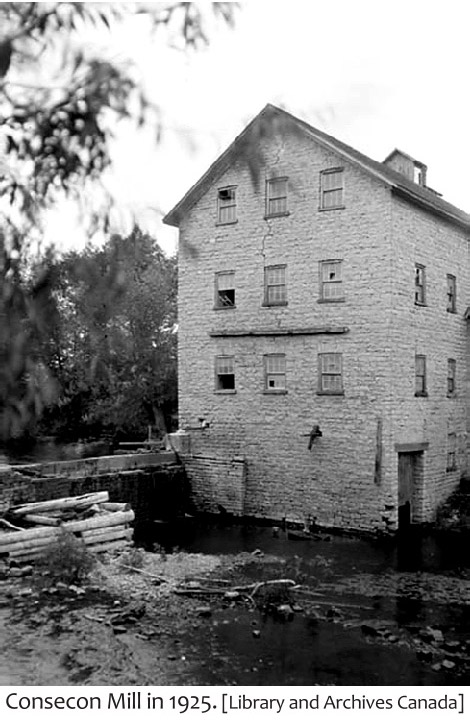
The village of Consecon grew around the grist mill that was built here in 1804. Despite its location on the shore of Wellers Bay, the town’s growth was limited by the lack of direct ship access to Lake Ontario. A barrier beach, one of five in Prince Edward County, cut off access from the bay to the lake. It wasn’t until the 1850s that Mother Nature granted ships access to Wellers Bay by the action of wind, wave and the seasonal breakup of winter ice on Lake Ontario which carved a channel through the barrier beach from the lake to the bay. The passage was deep and wide enough to allow steamboats and schooners to enter the bay. The steamer Chief Justice Robinson was the first steamboat to sail through the gap in 1856. Eventually, Consecon was designated as a customs port to facilitate the shipping trade with the United States, and two lighthouses were constructed at the western end of the Carrying Place to guide ships into Wellers Bay.
In 1911, the Central Ontario Railway became part of the Canadian Northern Railway, and this line was later nationalized by the government of Canada and merged into the Canadian National Railways. Local passenger service was eventually discontinued, but the cement plant in Picton continued to use the rail line for some time. In 1985, the railway between Trenton and Picton was shut down permanently and the Consecon Railway Station was closed.
When iron ore deposits were discovered 60 kilometers north, in the Marmora area, the railway was extended to the iron mines in 1882 and renamed the Central Ontario Railway. In Wellers Bay, a 600 meter long dock was built at Pine Point, and a railway spur line (still visible near kilometer-zero) connected it to the main line to allow trains to bring the ore directly to ships for transportation to steel mills in the United States. A machine shop and round house were also built there. It was soon found, however, that the high sulphur content of the iron ore from the Marmora mines made it inferior to ore from mines in Michigan, so exports to American markets quickly dwindled. Exports of other commodities including locally harvested whitefish, apples, barley, and wheat continued to be loaded onto trains and ships at Consecon.
In the late 19th and early 20th centuries, canning factories were established throughout Prince Edward County, including one at Consecon built by Alex Lipson in 1929 and located on the shore of Wellers Bay. This factory canned peas, tomatoes, beans and corn, all of which were shipped in boxcars from the Consecon Railway Station. The Consecon Canning Factory is now gone. Only the street on which it was located, Lipson Avenue, remains as a reminder of the factory which closed in 1978.
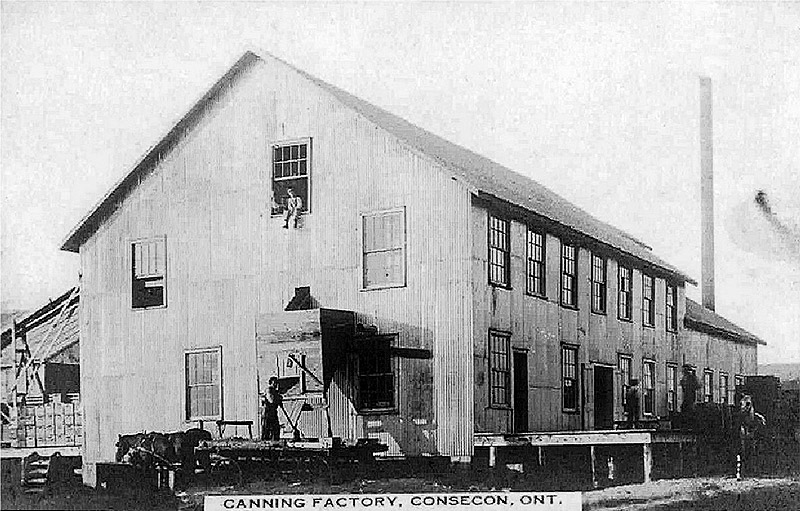
Canning Factory
Researched and written by Marc Seguin, 2023. marc@ontariohistory.ca
SOURCES
- Bentley, David. Notes from his architecture walking tour of Consecon, 2014. PEC Archives.
- Canniff, William. History of the Settlement of Upper Canada. Toronto, 1869.
- Crawford, Douglas. County Canners: A History of the Canning Industry in Prince Edward County.
Bloomfield, 2000. - Lunn, Richard & Lunn, Janet. The County: The First Hundred Years in Loyalist Prince Edward. Picton, 1967.
- Plomer, James & Capon, Alan R. Desperate Venture: Central Ontario Railway. Belleville, 1979.
- 7th Town Historical Society. 7th Town/Ameliasburgh Township, Past & Present. Ameliasburgh, 199?
- 7th Town Historical Society. Gunshot and Gleanings of the Historic Carrying Place, Bay of Quinte.
Ameliasburgh, 1987. - Squire, Rev. Bowen P. "The Squire Site, Consecon ", Archaeology Ontario, v.OA4, 1958.
- 7th Town Historical Society. Gunshot and Gleanings of the Historic Carrying Place, Bay of Quinte.
Ameliasburgh, 1987.


